英语四级作文预测移动支付
- 格式:docx
- 大小:10.29 KB
- 文档页数:3
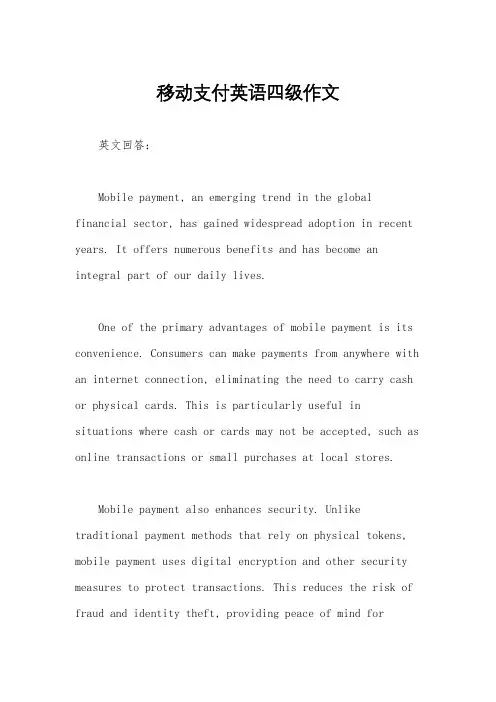
移动支付英语四级作文英文回答:Mobile payment, an emerging trend in the global financial sector, has gained widespread adoption in recent years. It offers numerous benefits and has become an integral part of our daily lives.One of the primary advantages of mobile payment is its convenience. Consumers can make payments from anywhere with an internet connection, eliminating the need to carry cash or physical cards. This is particularly useful insituations where cash or cards may not be accepted, such as online transactions or small purchases at local stores.Mobile payment also enhances security. Unliketraditional payment methods that rely on physical tokens, mobile payment uses digital encryption and other security measures to protect transactions. This reduces the risk of fraud and identity theft, providing peace of mind forconsumers.Furthermore, mobile payment offers the potential for financial inclusion. In regions with limited access to traditional banking services, mobile payment can provide individuals with a convenient and accessible way to manage their finances. By leveraging the reach of mobile networks, mobile payment can extend financial services to underserved populations.However, it is important to acknowledge some of the challenges associated with mobile payment. One concern is privacy. Mobile payment systems collect a significant amount of data about consumer spending habits and locations. This data can be used for targeted advertising orpotentially shared with third parties without consent.Another challenge lies in the interoperability ofmobile payment systems. Different systems and platforms may not be compatible with each other, creating barriers to widespread adoption. Users may have to choose between multiple mobile payment apps or face limitations whenmaking payments across different platforms.To address these challenges, it is essential for governments, regulators, and industry players to collaborate in establishing clear regulations and standards for mobile payment systems. This will help ensure the privacy and security of consumer data, promote interoperability between platforms, and foster a competitive and innovative environment.In conclusion, mobile payment has revolutionized the way we make transactions. Its convenience, security, and potential for financial inclusion make it a compelling option for consumers worldwide. While it faces some challenges related to privacy and interoperability, concerted efforts from stakeholders can pave the way for the continued growth and success of mobile payment systems.中文回答:随着科技的进步,移动支付已经成为不可或缺的金融方式,极大方便了我们的日常生活。
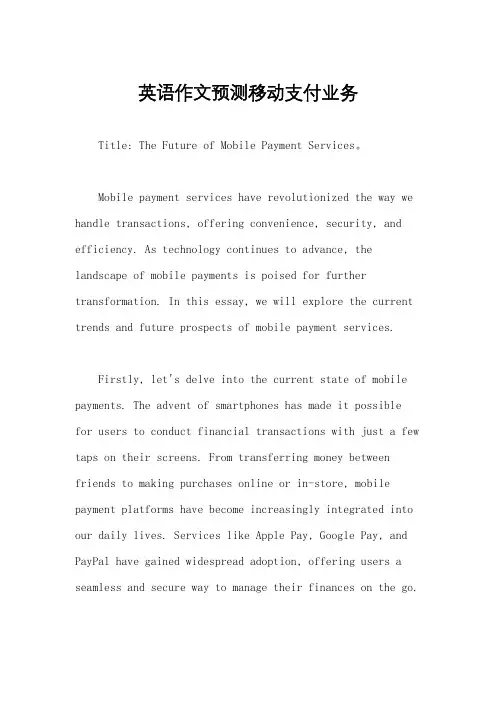
英语作文预测移动支付业务Title: The Future of Mobile Payment Services。
Mobile payment services have revolutionized the way we handle transactions, offering convenience, security, and efficiency. As technology continues to advance, the landscape of mobile payments is poised for further transformation. In this essay, we will explore the current trends and future prospects of mobile payment services.Firstly, let's delve into the current state of mobile payments. The advent of smartphones has made it possiblefor users to conduct financial transactions with just a few taps on their screens. From transferring money between friends to making purchases online or in-store, mobile payment platforms have become increasingly integrated into our daily lives. Services like Apple Pay, Google Pay, and PayPal have gained widespread adoption, offering users a seamless and secure way to manage their finances on the go.One of the key advantages of mobile payment services is their convenience. With just a smartphone and an internet connection, users can make transactions anytime, anywhere. Whether you're buying groceries at the supermarket or splitting the bill at a restaurant, mobile payments eliminate the need for physical cash or cards, streamlining the checkout process and reducing friction for both consumers and merchants.Moreover, mobile payment services offer enhanced security features compared to traditional payment methods. Most platforms use encryption and tokenization to protect users' financial information, reducing the risk of fraud and unauthorized access. Additionally, biometric authentication methods such as fingerprint or face recognition add an extra layer of security, ensuring that only authorized users can access their accounts.Looking ahead, the future of mobile payment services looks promising, with several emerging trends shaping the industry. One such trend is the rise of contactless payments. With the ongoing COVID-19 pandemic highlightingthe importance of hygiene and social distancing, contactless payment methods have surged in popularity. NFC-enabled smartphones and wearable devices allow users to make transactions without physically touching a payment terminal, further enhancing convenience and safety.Another key trend is the integration of mobile payments into other digital services. We are witnessing a convergence of fintech with other sectors such as e-commerce, ride-hailing, and food delivery. Companies are increasingly incorporating payment functionalities into their apps and platforms, creating seamless ecosystems where users can shop, order, and pay without ever leaving the app.Furthermore, the adoption of blockchain technology holds great potential for the future of mobile payments. Blockchain-based payment networks offer several advantages, including lower transaction fees, faster settlement times, and increased transparency. By leveraging decentralized ledgers, mobile payment services can offer users greater control over their funds and reduce reliance onintermediaries such as banks or payment processors.In conclusion, mobile payment services have come a long way since their inception, offering users unprecedented convenience, security, and efficiency. As technology continues to evolve, we can expect further innovations in the mobile payment industry, driven by trends such as contactless payments, integration with other digital services, and the adoption of blockchain technology. Ultimately, mobile payments will continue to reshape the way we conduct financial transactions, ushering in a new era of digital commerce.。
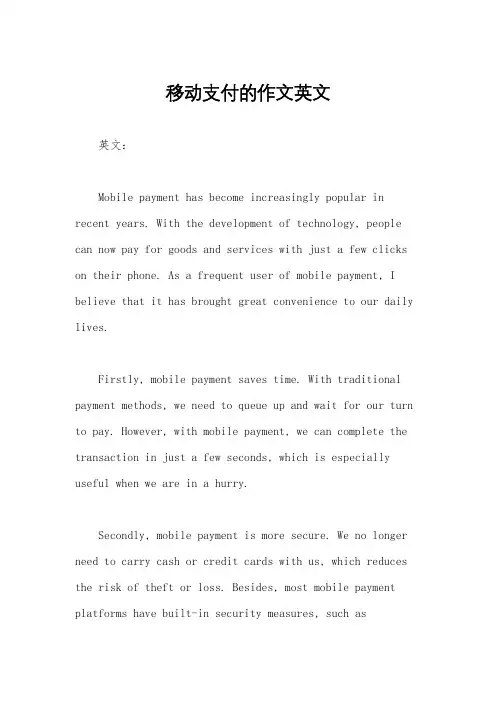
移动支付的作文英文英文:Mobile payment has become increasingly popular in recent years. With the development of technology, people can now pay for goods and services with just a few clicks on their phone. As a frequent user of mobile payment, I believe that it has brought great convenience to our daily lives.Firstly, mobile payment saves time. With traditional payment methods, we need to queue up and wait for our turn to pay. However, with mobile payment, we can complete the transaction in just a few seconds, which is especially useful when we are in a hurry.Secondly, mobile payment is more secure. We no longer need to carry cash or credit cards with us, which reduces the risk of theft or loss. Besides, most mobile payment platforms have built-in security measures, such asfingerprint recognition and facial recognition, which makeit difficult for others to access our accounts.Thirdly, mobile payment is more flexible. We can use it to pay for almost anything, from groceries to movie tickets, from online shopping to restaurant bills. Moreover, some mobile payment platforms offer discounts and cashback rewards, which can help us save money.However, there are also some disadvantages of mobile payment. For example, some people may find it difficult to use, especially the elderly or those who are not familiar with technology. Moreover, mobile payment relies on astable internet connection, which may not be available in some areas.In conclusion, mobile payment is a convenient, secure, and flexible payment method that has changed the way we pay for goods and services. As technology continues to advance, I believe that mobile payment will become even more popular in the future.中文:移动支付近年来越来越受欢迎。

移动支付英语作文(10篇)移动支付英语作文5 移动支付英语作文6 移动支付英语作文8 移动支付英语作文9In our life, I found that in addition to the phone number, account and password, there is a twodimensional code, is quietly into our life, it makes our life more interesting. It was a weekend afternoon when my mother finally agreed to buy me a third order Rubiks Cube. I excitedly took my mother and rushed to the toy store. At the thought of getting the heart read Rubiks Cube, the in the mind excited hate can not jump three feet high. But to the store, I found that my mother did not take money at all, no one dollar. Mother will not amuse me, must also seize the opportunity for me to carry on an "opportunistic education", what playthings lost, what to save money, what to do meaningful things. Its always that. Hum, no matter, this time I must get the Rubiks Cube. I angrily picked the most beautiful and expensive Rubiks Cube from the shelves, held it tightly in my hands, went straight to the cashier, and readily shouted for the bill. Then he pouted and looked at his mother. I saw my mother seems to understand and do not understand my language, began to bow to grope for the phone. Mom, whats that supposed to mean? Is it cheating?Unexpectedly playing mobile phone, I angry urgent, not by points, straight roar way: "dont buy dont buy, why cheat me." Mother saw first after a stunned, then still consider me to go to the cashier, handed the phone to the cashier. Oh, my God, no. Mom didnt burn her head out, did she? Shes trading her iPhone for a Rubiks Cube? Now it was my turn to freeze! But the aunt did not take over the phone, which made me relieved, but she immediately took out a scanner, in front of the mothers phone screen "drip" a sound, voice prompt payment success! Oh, thats incredible! Mobile phones can be used as money! Its wonderful!I turned from sadness to joy. However, a question has come, why can mobile phones be used as money? ! Mom seemed to see thatI dont understand, she waved the phones, smiled at me, eyes full of satisfied "this is the qr code WeChat payment function, as long as my bank card binding to it, to buy things when payment qr code as long as you scan the businessman, I can cary directly from the bank transfer the money to the other side, as with a zero wallet, mobile with qr code, I can go shopping without any cash with me!" So thats it! I was surprised and sighed! Hightech! After that, I became very interested in the QR code, andI found that if you havent scanned the QR code, youre out. Because even the old granny selling sugar cane juice on thestreet posted a QR code in front of the tricycle! QR codes have been posted all over stores and malls, everywhere. I can not help but sigh that the era we live in is really an era of wisdom, an era of progress, a best era!移动支付英语作文10I remember when I was in kindergarten, I went shopping in Wanda with my mother. At the time of payment, I saw my mother only took a small card to the shop assistant, we can take away the things to buy. I find it very strange, how can a card buy something? I asked my mother, my mother said: "this card is rich!" I took the card to see before, after see strange, no money ah? Mother smiled and said: "the bank will put the money into the card!"Wait for me to grow up a little bit, once and mother go out to have a meal, finish the meal to settle the bill, mother asked the cashier aunt: "can you use WeChat to pay?" The aunt said, "Yes." I saw my mother take out the phone, with the phone to scan the twodimensional code can be. On the way home, I asked my mother: "Mom, mobile phone and bank cards have no money on both sides!" Mother smiled and said: "didnt you see me grab the red envelope on the phone? There is money in the red envelope, and I have money after grabbing the red envelope!" I asked again:"Are you using the money to grab the red envelope to pay?" Mother smiled and said: "silly son, grab the red envelope money only a few cents ah! Thats because its tied to a bank card."Last month, we went shopping in the new huadu shopping mall. There were so many people waiting for us to check out that we had to walk to the automatic cash register next to us. Operating the automatic cash register is as simple as putting the barcode of the item on the scanner. I put the goods one by one on the code scanning machine after scanning again, my mother took out a mobile phone with Alipay to pay. "With automatic cash registers, waiting in line has been saved a lot of time." "A few years ago, we had to carry our wallets when we went shopping, and we were worried that our wallets would be stolen. Now when you go out, you just need to bring a mobile phone and everything is easy."A few days ago, I read a report on WeChat saying that foreigners who come to China for work or tourism are envious of mobile payment in China: taking a taxi, going shopping, registering at a hospital, and even street vendors can scan the QR code of their mobile phones to pay. They all say, "With a mobile phone, you can travel all over China". They also expect mobile payments to be available in their own countries. Afterreading, I smiled and said to my mother: "I believe that in the near future, mobile payment will cover the world."。
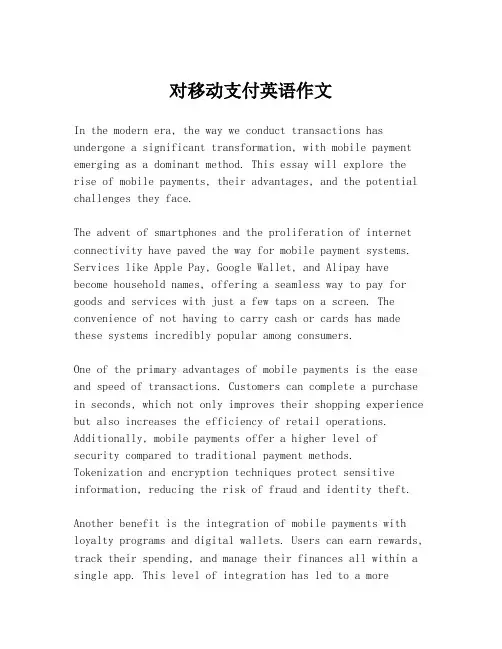
对移动支付英语作文In the modern era, the way we conduct transactions has undergone a significant transformation, with mobile payment emerging as a dominant method. This essay will explore the rise of mobile payments, their advantages, and the potential challenges they face.The advent of smartphones and the proliferation of internet connectivity have paved the way for mobile payment systems. Services like Apple Pay, Google Wallet, and Alipay have become household names, offering a seamless way to pay for goods and services with just a few taps on a screen. The convenience of not having to carry cash or cards has made these systems incredibly popular among consumers.One of the primary advantages of mobile payments is the ease and speed of transactions. Customers can complete a purchase in seconds, which not only improves their shopping experience but also increases the efficiency of retail operations. Additionally, mobile payments offer a higher level ofsecurity compared to traditional payment methods. Tokenization and encryption techniques protect sensitive information, reducing the risk of fraud and identity theft.Another benefit is the integration of mobile payments with loyalty programs and digital wallets. Users can earn rewards, track their spending, and manage their finances all within a single app. This level of integration has led to a morepersonalized and engaging consumer experience.However, despite these advantages, mobile payments also face challenges. One of the main concerns is the digital divide, where those without access to smartphones or the internet are excluded from the benefits of mobile payments. Additionally, there are issues of interoperability, as different payment platforms may not be compatible with each other, limiting the user experience.Privacy is another significant concern. As mobile payments collect a wealth of data on consumer spending habits, thereis a growing need for robust privacy policies and data protection regulations to ensure that this information is not misused.In conclusion, mobile payments represent a significant leap forward in the way we conduct financial transactions. They offer convenience, speed, and security, but they also present challenges that need to be addressed. As technology continues to evolve, it is crucial for stakeholders to work together to ensure that mobile payments are accessible, interoperable, and respectful of user privacy. The future of transactions lies in the palm of our hands, and mobile payments are leading the way.。
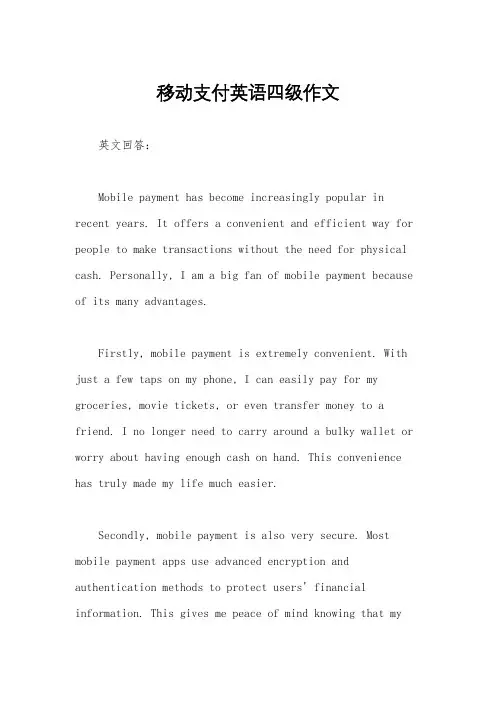
移动支付英语四级作文英文回答:Mobile payment has become increasingly popular in recent years. It offers a convenient and efficient way for people to make transactions without the need for physical cash. Personally, I am a big fan of mobile payment because of its many advantages.Firstly, mobile payment is extremely convenient. With just a few taps on my phone, I can easily pay for my groceries, movie tickets, or even transfer money to a friend. I no longer need to carry around a bulky wallet or worry about having enough cash on hand. This convenience has truly made my life much easier.Secondly, mobile payment is also very secure. Most mobile payment apps use advanced encryption and authentication methods to protect users' financial information. This gives me peace of mind knowing that mytransactions are safe and secure. In addition, many mobile payment apps also offer features such as fingerprint or facial recognition, adding an extra layer of security to the process.Furthermore, mobile payment has enabled me to take advantage of various discounts and rewards offered by different payment apps. For example, I often receive cashback or discounts on my purchases when using specific mobile payment apps. This not only saves me money but also encourages me to use mobile payment more frequently.In addition, mobile payment has also made splitting bills with friends much easier. Instead of dealing with the hassle of splitting cash or calculating who owes what, we can simply use a mobile payment app to transfer money to each other in a matter of seconds. This has definitely made social outings more enjoyable and stress-free.Overall, mobile payment has greatly improved my financial management and made my daily transactions more convenient. I can't imagine going back to relying solely oncash and credit cards for all my purchases.中文回答:移动支付在近年来变得越来越受欢迎。
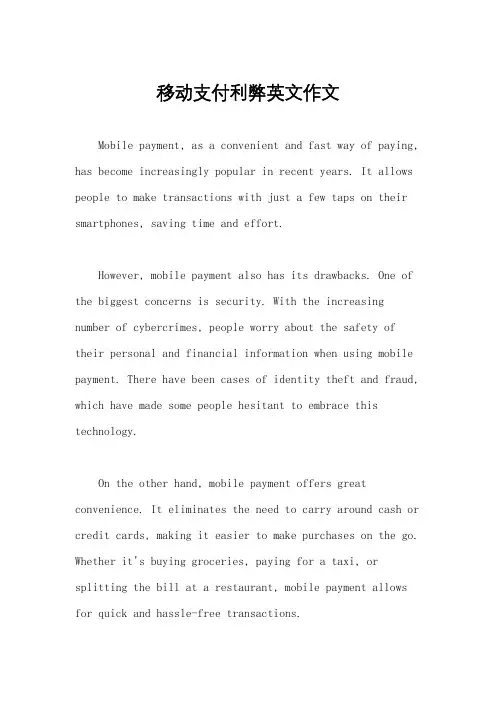
移动支付利弊英文作文Mobile payment, as a convenient and fast way of paying, has become increasingly popular in recent years. It allows people to make transactions with just a few taps on their smartphones, saving time and effort.However, mobile payment also has its drawbacks. One of the biggest concerns is security. With the increasing number of cybercrimes, people worry about the safety of their personal and financial information when using mobile payment. There have been cases of identity theft and fraud, which have made some people hesitant to embrace this technology.On the other hand, mobile payment offers great convenience. It eliminates the need to carry around cash or credit cards, making it easier to make purchases on the go. Whether it's buying groceries, paying for a taxi, or splitting the bill at a restaurant, mobile payment allows for quick and hassle-free transactions.Another disadvantage of mobile payment is the potential for overspending. With the ease of making purchases, some people may find it harder to keep track of their spending and end up overspending. This can lead to financial problems if not managed carefully.Despite its drawbacks, mobile payment has the potential to revolutionize the way we handle transactions. It has the power to make financial transactions more efficient and accessible, especially for those who do not have easy access to traditional banking services.In conclusion, mobile payment has both its advantages and disadvantages. While it offers convenience and efficiency, there are also concerns about security and overspending. As technology continues to advance, it is important for users to be aware of the risks and benefits of mobile payment and take necessary precautions to protect their personal and financial information.。
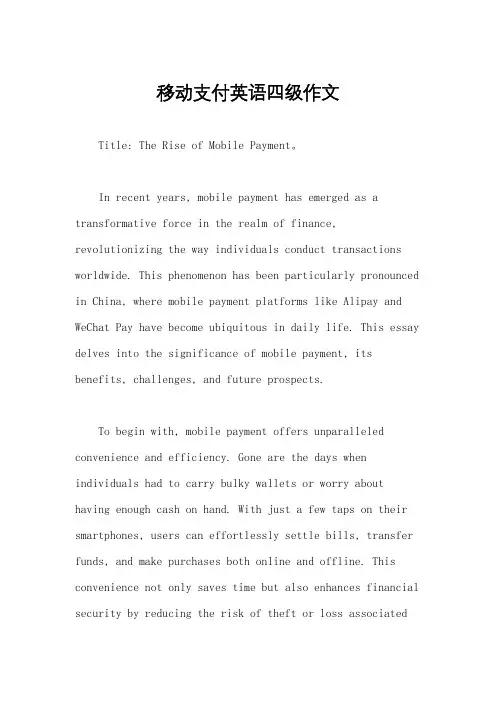
移动支付英语四级作文Title: The Rise of Mobile Payment。
In recent years, mobile payment has emerged as a transformative force in the realm of finance, revolutionizing the way individuals conduct transactions worldwide. This phenomenon has been particularly pronounced in China, where mobile payment platforms like Alipay and WeChat Pay have become ubiquitous in daily life. This essay delves into the significance of mobile payment, its benefits, challenges, and future prospects.To begin with, mobile payment offers unparalleled convenience and efficiency. Gone are the days when individuals had to carry bulky wallets or worry about having enough cash on hand. With just a few taps on their smartphones, users can effortlessly settle bills, transfer funds, and make purchases both online and offline. This convenience not only saves time but also enhances financial security by reducing the risk of theft or loss associatedwith traditional payment methods.Furthermore, mobile payment fosters financial inclusion by providing access to banking services for underserved populations. In many developing countries, where access to traditional banking infrastructure is limited, mobile payment serves as a lifeline, empowering individuals to participate in the formal economy and access essential financial services such as savings, loans, and insurance. This democratization of finance has the potential to alleviate poverty and promote economic development on a global scale.However, the widespread adoption of mobile payment also poses certain challenges and risks. One of the primary concerns is data privacy and security. As users entrust sensitive financial information to digital platforms, there is a growing need for robust cybersecurity measures to protect against hacking, fraud, and identity theft. Additionally, the dominance of a few major players in the mobile payment industry raises questions about competition and market concentration, potentially stifling innovationand consumer choice.Looking ahead, the future of mobile payment is brimming with possibilities. As technology continues to evolve, we can expect to see further integration of artificial intelligence, blockchain, and biometric authentication to enhance the security and reliability of mobile payment systems. Moreover, the rise of Internet of Things (IoT) devices and smart infrastructure opens up new avenues for seamless and interconnected payment experiences, from autonomous vehicles to smart appliances.In conclusion, mobile payment represents a paradigm shift in the way we perceive and engage with money. Its transformative impact extends beyond mere convenience, offering a gateway to financial inclusion, economic empowerment, and technological innovation. While challenges persist, the potential benefits are too significant to ignore. As we navigate the ever-changing landscape of digital finance, it is imperative to strike a balance between innovation and regulation to ensure that mobile payment remains a force for good in the global economy.。
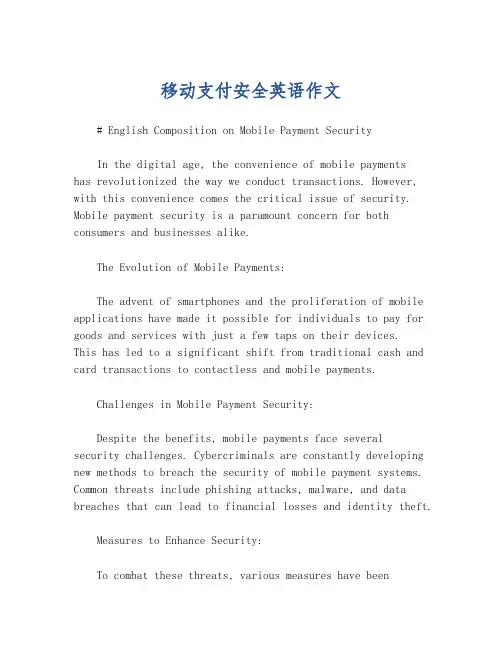
移动支付安全英语作文# English Composition on Mobile Payment SecurityIn the digital age, the convenience of mobile paymentshas revolutionized the way we conduct transactions. However, with this convenience comes the critical issue of security. Mobile payment security is a paramount concern for both consumers and businesses alike.The Evolution of Mobile Payments:The advent of smartphones and the proliferation of mobile applications have made it possible for individuals to pay for goods and services with just a few taps on their devices.This has led to a significant shift from traditional cash and card transactions to contactless and mobile payments.Challenges in Mobile Payment Security:Despite the benefits, mobile payments face severalsecurity challenges. Cybercriminals are constantly developing new methods to breach the security of mobile payment systems. Common threats include phishing attacks, malware, and data breaches that can lead to financial losses and identity theft.Measures to Enhance Security:To combat these threats, various measures have beenimplemented. These include:1. Encryption: Ensuring that all transactions are encrypted to prevent unauthorized access to sensitive data.2. Biometric Authentication: Utilizing fingerprints or facial recognition to verify the identity of the user.3. Tokenization: Replacing sensitive information with unique identification symbols that are useless if intercepted.4. Regular Software Updates: Encouraging users to keeptheir operating systems and apps updated to protect against known vulnerabilities.The Role of Users:Users play a crucial role in maintaining mobile payment security. They should:- Be vigilant about sharing personal information.- Use strong, unique passwords for their accounts.- Regularly monitor their financial transactions for any signs of fraud.Conclusion:While mobile payments offer unparalleled convenience,they must be used with caution. It is essential for both thetechnology providers and the users to remain vigilant and proactive in ensuring the security of mobile payment platforms. As technology advances, so too must our defenses against the ever-evolving threats in the digital landscape.# 移动支付安全英语作文在数字时代,移动支付的便利性彻底改变了我们的交易方式。
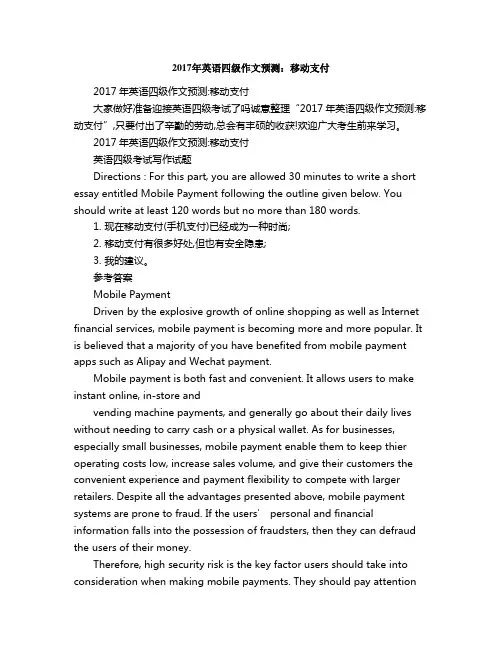
2017年英语四级作文预测:移动支付2017年英语四级作文预测:移动支付大家做好准备迎接英语四级考试了吗诚意整理“2017年英语四级作文预测:移动支付”,只要付出了辛勤的劳动,总会有丰硕的收获!欢迎广大考生前来学习。
2017年英语四级作文预测:移动支付英语四级考试写作试题Directions : For this part, you are allowed 30 minutes to write a short essay entitled Mobile Payment following the outline given below. You should write at least 120 words but no more than 180 words.1. 现在移动支付(手机支付)已经成为一种时尚;2. 移动支付有很多好处,但也有安全隐患;3. 我的建议。
参考答案Mobile PaymentDriven by the explosive growth of online shopping as well as Internet financial services, mobile payment is becoming more and more popular. It is believed that a majority of you have benefited from mobile payment apps such as Alipay and Wechat payment.Mobile payment is both fast and convenient. It allows users to make instant online, in-store andvending machine payments, and generally go about their daily lives without needing to carry cash or a physical wallet. As for businesses, especially small businesses, mobile payment enable them to keep thier operating costs low, increase sales volume, and give their customers the convenient experience and payment flexibility to compete with larger retailers. Despite all the advantages presented above, mobile payment systems are prone to fraud. If the users’ personal and financia l information falls into the possession of fraudsters, then they can defraud the users of their money.Therefore, high security risk is the key factor users should take into consideration when making mobile payments. They should pay attentionto carefully protect their payment accounts and passwords. Meanwhile, governments should develop a supportive regulatory environment in order to effectively manage the potential risks.点评:移动支付的快速发展给人们的生活带来了便捷,人们甚至不用带现金和钱包出门,只要将智能手机上的支付APP打开,经过简单的程序就能完成各类支付。
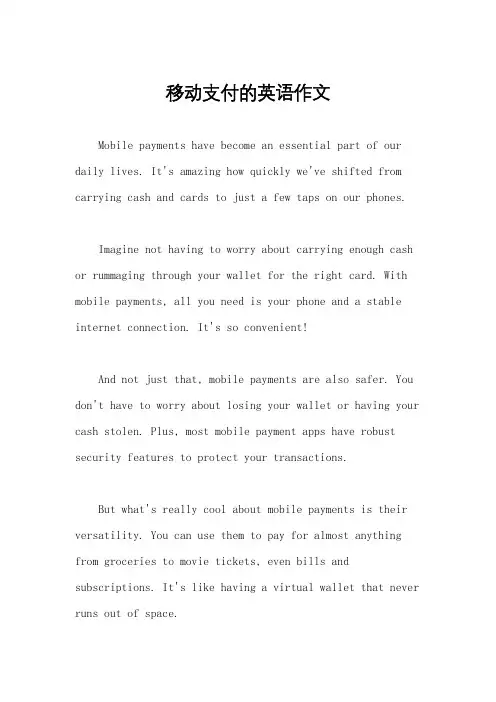
移动支付的英语作文Mobile payments have become an essential part of our daily lives. It's amazing how quickly we've shifted from carrying cash and cards to just a few taps on our phones.Imagine not having to worry about carrying enough cash or rummaging through your wallet for the right card. With mobile payments, all you need is your phone and a stable internet connection. It's so convenient!And not just that, mobile payments are also safer. You don't have to worry about losing your wallet or having your cash stolen. Plus, most mobile payment apps have robust security features to protect your transactions.But what's really cool about mobile payments is their versatility. You can use them to pay for almost anything from groceries to movie tickets, even bills and subscriptions. It's like having a virtual wallet that never runs out of space.Of course, there are some downsides too. Sometimes, the internet connection can be a bit unstable, making payments a bit slow or even impossible. And not everyone is comfortable with the idea of sharing their financial information with these apps.But overall, mobile payments have definitely made our lives easier and more convenient. I can't imagine going back to the days of carrying cash and cards everywhere. The future is definitely digital,。
英文作文移动支付1. Mobile payment has become an integral part of our lives. We no longer need to carry cash or credit cards with us everywhere we go. With just a few taps on our smartphones, we can easily make payments for our purchases. It's convenient and hassle-free.2. The rise of mobile payment has also brought about a change in consumer behavior. People are now more inclined to make impulsive purchases because they know they can easily pay for it using their mobile phones. This has led to an increase in sales for businesses and a boost in the economy.3. Mobile payment has also made it easier for people to split bills and share expenses. Gone are the days when we had to calculate who owes whom and how much. With mobile payment apps, we can simply send or request money from our friends and family, making it a seamless process.4. One of the biggest advantages of mobile payment is its security. Most mobile payment apps use encryption technology to protect our personal and financial information. This gives us peace of mind knowing that our transactions are safe and secure.5. Mobile payment has also opened up new opportunities for small businesses and entrepreneurs. With the ability to accept mobile payments, they can reach a wider customer base and compete with larger establishments. This has leveled the playing field and created a more dynamic and diverse marketplace.6. However, there are still some challenges that mobile payment needs to overcome. Not everyone has access to smartphones or reliable internet connections, which limits the adoption of mobile payment in certain areas. Additionally, there are concerns about privacy and data breaches that need to be addressed to ensure the continued trust of consumers.7. In conclusion, mobile payment has revolutionized theway we make transactions. It has made our lives more convenient, changed consumer behavior, and opened up new opportunities for businesses. While there are still challenges to overcome, the future of mobile payment looks promising.。
In the modern world, the evolution of technology has brought about a myriad of conveniences to our daily lives. One such convenience that has become an integral part of our society is mobile payment. As a high school student, I have witnessed and experienced the transformation of how we handle transactions, and I am here to share my perspective on this fascinating development.The first time I encountered mobile payment was during a school trip. We were at a bustling marketplace, and I was about to buy a snack when I realized I had left my wallet at home. Panicking, I was about to give up when a friend suggested using a mobile payment app. With a few taps on my phone, I was able to complete the transaction without any cash or card. This was a revelation to me, and it marked the beginning of my journey with mobile payments.Since that incident, I have come to appreciate the numerous benefits that mobile payment offers. The convenience it provides is unparalleled. Imagine being able to pay for anything, anywhere, anytime, without the need to carry cash or cards. This is the reality that mobile payment has brought to us. It has simplified the process of making payments, making life much easier for everyone, especially for busy students like me who are always on the go.Moreover, mobile payment has also enhanced security. Traditional methods of payment, such as cash or cards, are prone to loss or theft. However, with mobile payment, the risk of losing money is significantly reduced. The transactions are encrypted, and the use of biometricauthentication, such as fingerprint or facial recognition, adds an extra layer of security. This has given me peace of mind, knowing that my money is safe even when I am not physically holding it.Another advantage of mobile payment is the ease of tracking expenses. As a student, managing finances can be challenging, especially with the various expenses that come with school activities. With mobile payment, I can easily keep track of my spending habits. The apps provide detailed records of all transactions, which help me monitor my spending and make better financial decisions.However, despite its numerous benefits, mobile payment also has its drawbacks. One of the main concerns is the reliance on technology. In a world where everything is digital, the risk of cyberattacks is everpresent. There have been instances where hackers have managed to breach the security of mobile payment systems, leading to financial losses for users. This is a significant concern that needs to be addressed to ensure the safety and trust of users.Additionally, the adoption of mobile payment is not universal. There are still many places, especially in rural areas, where mobile payment is not accepted. This limits its accessibility and convenience. Efforts need to be made to expand the reach of mobile payment to ensure that everyone can benefit from its advantages.In conclusion, mobile payment has revolutionized the way we conduct transactions. As a high school student, I have personally experienced theconvenience, security, and ease of tracking expenses that it offers. However, it is crucial to address the concerns of security and accessibility to ensure that mobile payment can be fully embraced by everyone. With continuous improvements and advancements in technology, I am optimistic that mobile payment will continue to evolve and provide even greater benefits in the future.。
关于移动支付的英语作文英文回答:Mobile payment has become an increasingly popular way for people to make transactions, whether it's for shopping, dining out, or even splitting the bill with friends. I personally find mobile payment to be incredibly convenient and efficient. For example, when I go out for dinner with friends, we can easily split the bill using a mobile payment app without having to worry about having enough cash or dealing with the hassle of multiple credit card transactions. It's as easy as a few taps on our phones and the bill is settled.Not only is mobile payment convenient, but it also offers a sense of security. With features like fingerprint or facial recognition, I feel confident that my financial information is well-protected. In addition, the ability to track my expenses and transactions in real-time through the mobile payment app helps me stay on top of my budget andfinancial goals.Another advantage of mobile payment is the ability to make quick and contactless transactions, which isespecially important in today's world where hygiene and safety are a top priority. Whether I'm at a coffee shop ora grocery store, I can simply tap my phone to complete the transaction without having to handle physical cash or cards.中文回答:移动支付已经成为人们进行交易的一种越来越流行的方式,无论是购物、外出就餐,还是和朋友一起分账。
移动支付英语作文四级Title: The Evolution and Impact of Mobile Payment。
In recent years, mobile payment has emerged as a ubiquitous aspect of modern life, revolutionizing the way we conduct transactions. This essay aims to delve into the evolution, benefits, challenges, and future prospects of mobile payment systems.To begin with, the evolution of mobile payment can be traced back to the advent of smartphones and the increasing connectivity they offer. With the rise of mobile internet, consumers found it more convenient to perform financial transactions using their mobile devices. This led to the development of various mobile payment platforms such as Apple Pay, Google Pay, and numerous others.One of the primary benefits of mobile payment is its convenience. Gone are the days when individuals had to carry bulky wallets or remember multiple PINs for differentcards. With mobile payment, all it takes is a few taps on the smartphone screen to complete a transaction. Moreover, mobile payment systems often integrate loyalty programs and discounts, further enhancing the user experience.Additionally, mobile payment enhances financial inclusion by providing access to banking services for individuals who may not have easy access to traditional banking infrastructure. This is particularly significant in rural areas and developing countries where physical banks may be scarce. Mobile payment allows people to send, receive, and store money securely, thereby empowering them economically.Furthermore, mobile payment contributes to the digitization of economies, leading to greater efficiency and transparency. By reducing the reliance on cash, mobile payment helps curb illicit activities such as money laundering and tax evasion. Moreover, digital transactions leave a trail of data that can be analyzed to gain insights into consumer behavior, which can inform businesses and policymakers alike.However, despite its numerous advantages, mobile payment also faces several challenges. One of the primary concerns is security. As transactions occur electronically, there is always the risk of data breaches and unauthorized access. Ensuring robust encryption and authentication mechanisms is crucial to mitigate these risks and build trust among users.Moreover, interoperability remains a challenge in the mobile payment ecosystem. With numerous platforms vying for dominance, users may find it cumbersome to navigate between different apps and systems. Establishing interoperable standards and protocols can promote seamless integration and foster greater adoption of mobile payment technologies.Looking ahead, the future of mobile payment appears promising. With advancements in biometric authentication and blockchain technology, mobile payment systems are becoming even more secure and efficient. Moreover, the ongoing shift towards a cashless society driven by the COVID-19 pandemic is likely to accelerate the adoption ofmobile payment globally.In conclusion, mobile payment has transformed the way we transact, offering convenience, financial inclusion, and greater efficiency. While challenges such as security and interoperability persist, ongoing innovations promise to overcome these obstacles. As we embrace the digital age, mobile payment will continue to play a pivotal role in shaping the future of commerce and finance.。
移动支付的英语作文Title: The Evolution and Impact of Mobile Payment。
In recent years, mobile payment has emerged as a transformative force in the realm of finance and commerce, revolutionizing the way individuals conduct transactions and interact with businesses. This essay delves into the evolution, advantages, challenges, and future prospects of mobile payment.Firstly, it is imperative to elucidate the evolution of mobile payment. Initially, mobile payment was a rudimentary concept, primarily involving the use of SMS-based transactions. However, with the advent of smartphones and advanced mobile technologies, the landscape underwent a paradigm shift. Payment apps such as PayPal, Alipay, and WeChat Pay gained prominence, offering users a seamless and secure platform to make transactions.One of the primary advantages of mobile payment is itsunparalleled convenience. Gone are the days when individuals had to carry physical wallets or queue at ATMs to withdraw cash. With mobile payment, transactions can be completed swiftly using smartphones, eliminating the need for cash or physical cards. Moreover, mobile payment facilitates peer-to-peer transactions, allowing users to transfer funds instantaneously to friends and family, irrespective of geographical barriers.Furthermore, mobile payment promotes financial inclusion by providing access to banking services for the unbanked and underbanked populations. In many developing countries, where traditional banking infrastructure is lacking, mobile payment serves as a lifeline, enabling individuals to engage in financial activities such as savings, remittances, and bill payments. This, in turn, fosters economic empowerment and uplifts marginalized communities.Nevertheless, mobile payment is not devoid of challenges. One of the foremost concerns pertains to security and privacy issues. Given the sensitive nature offinancial transactions, there is a looming threat of data breaches, identity theft, and fraudulent activities. Therefore, it is imperative for mobile payment providers to bolster their security protocols through encryption, biometric authentication, and robust anti-fraud measures to instill confidence among users.Moreover, interoperability remains a significant hurdle in the widespread adoption of mobile payment. With multiple players vying for market dominance, interoperability issues arise, leading to fragmentation and inconvenience for users. Efforts must be made to establish standardization and interoperable frameworks to facilitate seamlesstransactions across different platforms and ecosystems.Looking ahead, the future of mobile payment appears promising, fueled by advancements in technology such as blockchain, artificial intelligence, and Internet of Things (IoT). These innovations hold the potential to enhance the security, efficiency, and user experience of mobile payment systems. Additionally, the proliferation of contactless payments and wearable devices is poised to further catalyzethe adoption of mobile payment, ushering in a cashless society.In conclusion, mobile payment has emerged as a disruptive force, reshaping the landscape of financial transactions and empowering individuals with unprecedented convenience and accessibility. While challenges persist, the transformative potential of mobile payment is undeniable, heralding a future where cashless transactions are the norm, driving economic growth and fostering financial inclusion on a global scale.。
移动与支付英文作文1. I love using mobile payment because it's so convenient. Just a few taps on my phone and I can pay for my coffee, groceries, or even split the bill with friends.2. It's amazing how technology has made it possible for us to shop online and pay with just a touch of a button. No more fumbling for cash or waiting in long lines at the store.3. Mobile wallets have also made it easier to keep track of my expenses. I can see all my transactions in one place and set budget reminders to help me stay on track.4. I feel more secure using mobile payment because I don't have to carry around a lot of cash. Plus, many apps offer extra security features like fingerprint or face recognition.5. With mobile payment, I can easily send money tofamily and friends, whether they're across the street or across the country. It's quick, easy, and hassle-free.6. The best part about mobile payment is that it's always evolving. New features and innovations are constantly being introduced to make our lives easier and more convenient.。
2017年英语四级作文预测:移动支付
2017年英语四级作文预测:移动支付
大家做好准备迎接英语四级考试了吗诚意整理“2017年英语四级作文预测:移动支付”,只要付出了辛勤的劳动,总会有丰硕的收获!欢迎广大考生前来学习。
2017年英语四级作文预测:移动支付
英语四级考试写作试题
Directions : For this part, you are allowed 30 minutes to write a short essay entitled Mobile Payment following the outline given below. You should write at least 120 words but no more than 180 words.
1. 现在移动支付(手机支付)已经成为一种时尚;
2. 移动支付有很多好处,但也有安全隐患;
3. 我的建议。
参考答案
Mobile Payment
Driven by the explosive growth of online shopping as well as Internet financial services, mobile payment is becoming more and more popular. It is believed that a majority of you have benefited from mobile payment apps such as Alipay and Wechat payment.
Mobile payment is both fast and convenient. It allows users to make instant online, in-store and
vending machine payments, and generally go about their daily lives without needing to carry cash or a physical wallet. As for businesses, especially small businesses, mobile payment enable them to keep thier operating costs low, increase sales volume, and give their customers the convenient experience and payment flexibility to compete with larger retailers. Despite all the advantages presented above, mobile payment systems are prone to fraud. If the users’ personal and financia l information falls into the possession of fraudsters, then they can defraud the users of their money.
Therefore, high security risk is the key factor users should take into consideration when making mobile payments. They should pay attention
to carefully protect their payment accounts and passwords. Meanwhile, governments should develop a supportive regulatory environment in order to effectively manage the potential risks.
点评:
移动支付的快速发展给人们的生活带来了便捷,人们甚至不用带现金和钱包出门,只要将智能手机上的支付APP打
开,经过简单的程序就能完成各类支付。
但是与此同时,移动支付对支付的安全提出了更高的要求。
伺机已久的黑客们也抓住这一新兴产业的漏洞,将手伸进人们的“移动口袋”里。
因此,用户在使用过程中应保持高度警惕,另外,政府部门也应该提升相关的监管力度。
文章第一段指出移动支付盛行这一现象;第二段分析了移动支付的利弊;第三段作者结合自己的观点提出建议。
Alipay和Wechat payment都是手机支付的常用APP,分别指支付宝和微信支付;go about one’s daily lives 意为“忙于日常生活”; be prone to sth.意为“易于受。
的影响;有。
的倾向”;fall into the possession of sb.意为“被某人占有; 落入某人手中”;fraudster意为“行骗者”;defraud sb. of sth.意为“从某人处骗取某物”;high security risk意为“高度的安全风险”;take sth. into consideration意为“考虑到,顾及”;payment accounts and passwords意为“支付账号和密码”。
supportive regulatory environment意为“有力的监管环境”。
英语考试为您整理提供:
英语口语考试
英语四级考试时间
英语四级英语六级
四六级英语成绩查询时间
相关文档:
•
•
•
•
•
•
•
•
•
•
更多相关文档请访问:。